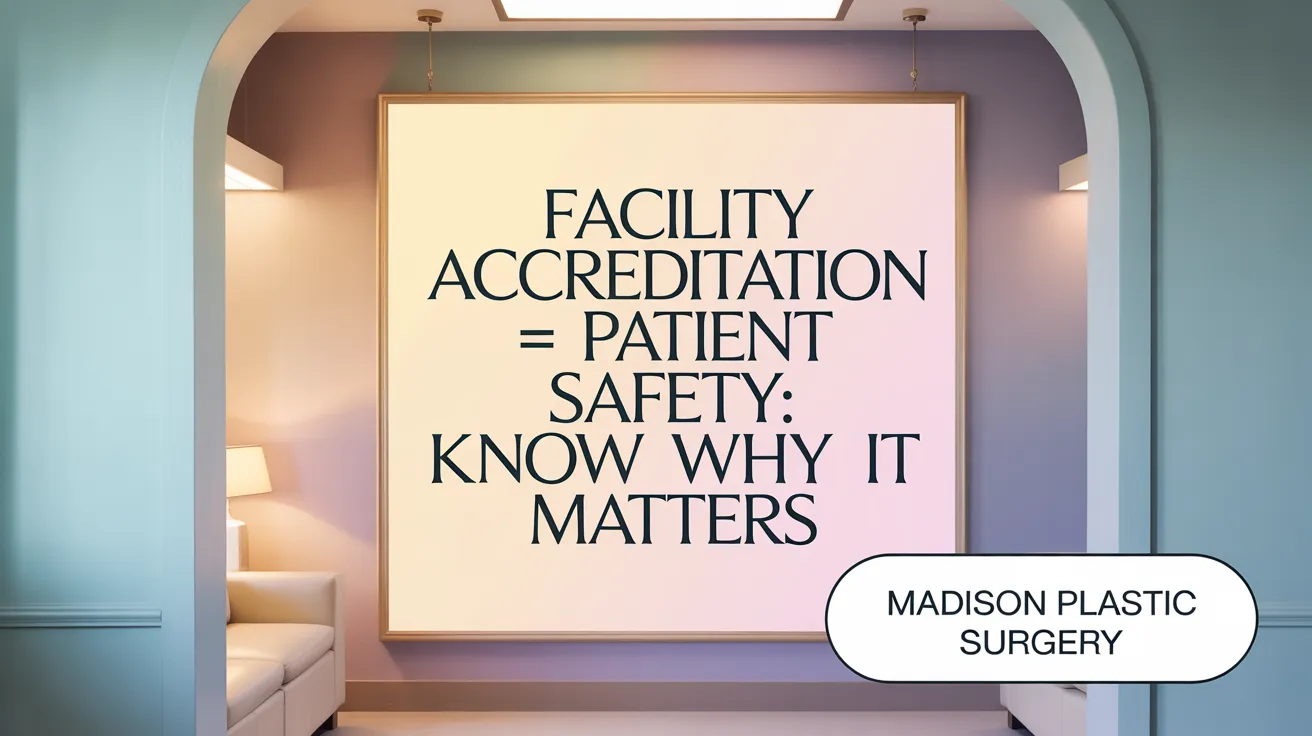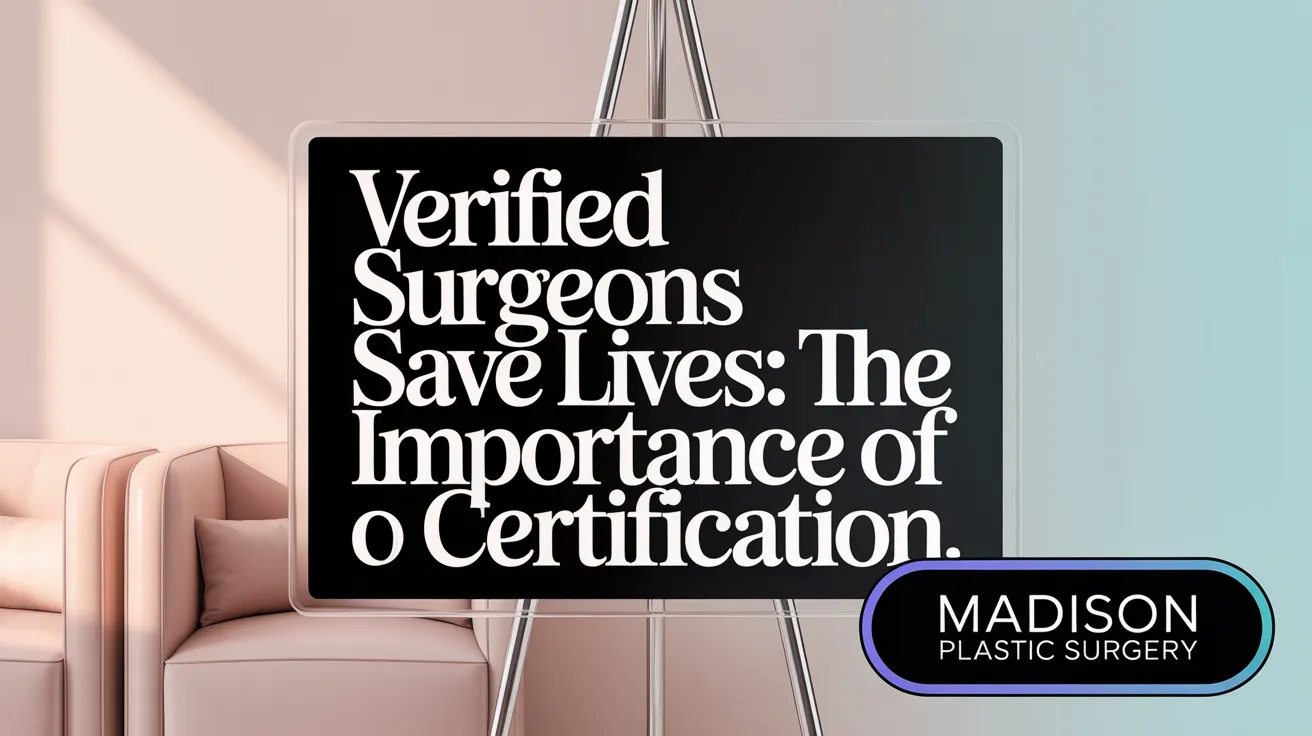Introduction to Safety and Accreditation in Cosmetic Surgery
Cosmetic surgery is a growing field that offers transformative results, but it carries inherent risks that necessitate stringent safety standards. Understanding the importance of both surgeon certification and facility accreditation can empower patients to make informed decisions and ensure optimal care. This article explores the critical facets of safety protocols in cosmetic surgery clinics, emphasizing the assurance that accredited facilities and board-certified surgeons provide.
What Does Facility Accreditation Mean for Patient Safety?

What is facility accreditation and why is it important?
Facility accreditation is a voluntary external evaluation process that measures whether a healthcare facility meets recognized standards of quality and safety. It ensures that surgical centers comply with strict regulations regarding equipment, safety protocols, qualified staff, and emergency preparedness. This process promotes continuous quality assurance and helps facilities maintain regulatory compliance, ultimately enhancing patient safety.
What standards do accredited cosmetic surgery facilities meet?
Accredited facilities adhere to rigorous national standards. They are equipped with up-to-date emergency resuscitation tools and maintain sterile, well-maintained operating rooms. Facilities must meet cleanliness criteria, building codes, and include licensed personnel such as anesthesiologists and nurses. In addition, accredited centers comply with privacy laws like HIPAA to protect patient information.
Types of accrediting organizations
Several recognized organizations provide accreditation for surgical centers, including the American Association for Accreditation of Ambulatory Surgery Facilities (AAAASF), Accreditation Association for Ambulatory Health Care (AAAHC), and The Joint Commission. Facilities may also hold state licenses or Medicare certifications that ensure adherence to safety and operational standards.
Benefits of choosing an accredited facility
Choosing an accredited facility decreases the risk of complications, infections, and medication errors. Accredited ambulatory surgery centers report serious complication rates of less than 0.5% and very low mortality rates (less than 1 in 57,000). These centers also maintain qualified and adequately trained staff ready to respond to emergencies, contributing to superior patient outcomes.
How can patients verify if a facility is accredited?
Patients can verify accreditation status by consulting official accrediting organizations such as AAAASF, AAAHC, or The Joint Commission. Surgeons' websites or direct communication with certifying bodies can also confirm accreditation credentials.
Safety outcomes in accredited versus non-accredited facilities
Non-accredited clinics often have higher rates of postoperative infections, medication errors, and surgical complications, which can lead to serious health risks or fatalities. Conversely, accredited facilities follow strict protocols, emergency preparedness plans, and continuous staff training, substantially reducing these risks.
This clear distinction underscores the importance of selecting accredited facilities to maximize patient safety in cosmetic surgery.
The Crucial Role of Surgeon Certification in Ensuring Safety

Why is board certification important for cosmetic surgeons?
Board certification is a critical marker of a surgeon's qualifications and commitment to patient safety. It shows that the surgeon has completed extensive, accredited training and has passed rigorous examinations in plastic or cosmetic surgery. Certified surgeons adhere to high standards concerning their knowledge, skills, and ethical practice. This rigorous process helps minimize surgical risks, manage complications effectively, and ultimately results in better patient outcomes. For more details on importance of patient safety in plastic surgery and the safety standards the best plastic surgeons adhere to.
What certifying boards oversee cosmetic and plastic surgeons?
Several recognized boards certify cosmetic and plastic surgeons. The American Board of Plastic Surgery (ABPS) is the only board recognized by the American Board of Medical Specialties (ABMS) specifically for plastic surgery. The American Board of Cosmetic Surgery (ABCS) and the American Board of Facial Cosmetic Surgery (ABFCS) provide additional certification paths focusing exclusively on cosmetic and facial cosmetic surgery. These boards require surgeons to complete specialized fellowship training, perform a minimum number of cosmetic procedures, and pass rigorous written and oral exams to ensure expertise. Learn more about ABCS Certification Criteria and Surgeon Safety Standards and cosmetic surgery board certifications and fellowships.
Training, exams, and ongoing education
Certified surgeons undergo years of specialized training beyond medical school, including multi-year residencies and fellowships. They must perform a large volume of surgical procedures under supervision before certification. Continuing medical education is mandatory, with re-certification exams typically every ten years to maintain high standards and stay current with advances. More information is available on plastic surgery certification and continuous education and certified cosmetic surgeons training and expertise.
How can patients verify a surgeon’s certification?
Patients can confirm a surgeon’s certification status through official board websites such as ABPS or ABCS, which maintain searchable directories. This verification is essential to ensure that the surgeon has the appropriate qualifications, continues learning, and follows a professional code of ethics. You can find a board-certified cosmetic surgeon here and verify certifications with ABPS verification systems.
Link between surgeon certification and patient outcomes
Studies and safety data show that surgeries performed by board-certified surgeons in accredited facilities result in significantly lower complication rates and mortality. Certification correlates strongly with patient safety and the quality of care offered. Explore research on accredited facilities and patient safety and outpatient surgery safety and accreditation data.
Ethical standards and professional accountability
Board-certified surgeons are held to strict ethical standards and professional accountability. These include prioritizing patient well-being, transparent communication, informed consent, and respecting privacy laws. Surgeons with suspended licenses or unethical practices typically cannot maintain certification, offering patients an additional layer of protection and trust. For further insights, refer to ethical standards in cosmetic surgery and regulatory frameworks and complaint mechanisms in cosmetic surgery.
Safety Protocols and Standards Within Accredited Cosmetic Surgery Clinics

What safety protocols are practiced in accredited cosmetic surgery clinics?
Accredited cosmetic surgery clinics uphold rigorous safety protocols to ensure patient well-being. These include stringent sterilization practices such as hand hygiene, proper disposal of needles, use of personal protective equipment (PPE), and regular surface disinfection. Operational procedures involve preoperative verification, accurate patient identification, marking the surgical site, and conducting a mandatory intraoperative 'time out' to prevent wrong-site or wrong-person surgeries.
How is anesthesia safety ensured?
Anesthesia safety in these clinics is guaranteed by employing board-certified anesthesiologists along with trained and licensed nursing staff. At least one staff member certified in Advanced Cardiac Life Support (ACLS) must be present during surgery. Facilities are equipped with up-to-date emergency resuscitation equipment and maintain continuous patient monitoring to respond promptly to any anesthesia-related complications.
What patient care processes enhance safety?
Patient safety is further enhanced through comprehensive preoperative evaluations that review medical history, physical health, and psychological readiness when required. Informed consent is a priority, ensuring patients understand the risks, benefits, and alternatives to surgery. Postoperative care includes close monitoring and follow-up visits aimed at early detection and management of any complications, promoting a smooth recovery.
Additional Operational and Clinical Standards
- Clinics operate in accredited facilities that meet strict national standards for safety and cleanliness.
- Emergency preparedness includes having protocols and equipment ready for immediate response.
- Surgical staff, including surgeons and anesthesiologists, must be board-certified and maintain current licensing.
- Updated surgical techniques and perioperative antibiotics are used to reduce infection risks and improve recovery times.
These coordinated safety measures establish a secure environment, minimizing complications and enhancing outcomes in cosmetic surgery.
Global and Regulatory Perspectives on Cosmetic Surgery Safety
How do regulatory frameworks affect cosmetic surgery safety internationally?
Regulatory frameworks in countries like the USA, Australia, the UK, and Italy play a pivotal role in ensuring cosmetic surgery safety. They require clear differentiation between plastic surgeons and cosmetic surgeons based on specialized training and certification. For instance, Australia mandates fellowship completion with the Royal Australasian College of Surgeons (RACS) to be recognized as a plastic surgeon. Learn more about global regulations and standards in cosmetic surgery.
Informed consent processes are strictly enforced globally, involving detailed discussions about risks, procedure outcomes, anesthesia, costs, and use of images. Cooling-off periods, such as the minimum seven days in Australia, are common, allowing patients time to reconsider their decisions. Ethical advertising is regulated to prevent misleading claims or sensationalism in advertisements.
Psychological evaluation is emphasized, especially to detect conditions like body dysmorphic disorder (BDD), ensuring candidates are mentally suitable for surgery. These frameworks are designed to uphold ethical practices, protect patient welfare, and promote transparency. Detailed overview of cosmetic surgery regulations and patient safety considerations.
What standards govern the use of medical devices in cosmetic surgery?
Medical devices, including implants and injectable products, are governed by rigorous regulatory standards internationally. In the USA, devices must be approved by the FDA, while Australia's Therapeutic Goods Administration (TGA) oversees approval and mandates distribution of informational leaflets and implant cards. The UK regulates devices through the Medicines and Healthcare products Regulatory Agency (MHRA), and European Union CE marks validate device safety across member countries.
These regulations ensure medical devices meet strict safety, efficacy, and quality standards. Patients receive comprehensive information for informed decision-making and traceability of devices used during their treatment. More on regulatory frameworks and medical device safety in cosmetic surgery.
What legal protections do patients have?
Patients subjected to malpractice or unethical practices have multiple legal protections. They may file complaints with medical regulatory boards, which investigate and can enforce disciplinary actions. Civil lawsuits offer another avenue for compensation in cases of negligence or harm.
Regulatory bodies define clear complaint mechanisms, ensuring accountability and safeguarding patient rights. These protections encourage high professional standards and contribute to the overall safety of cosmetic surgery practices worldwide. Explore legal recourse and patient protections in plastic surgery.
Empowering Patients: Choosing Certified Surgeons and Accredited Clinics

Why is patient education on accreditation and certification vital?
Many patients choose cosmetic surgery providers influenced by social media presence, promotional pricing, or reviews, which do not necessarily reflect safety or qualifications. Educating patients about the importance of selecting board-certified surgeons who operate in accredited facilities helps improve surgical outcomes and reduce the risk of complications. Knowledge about certification and accreditation empowers patients to make informed decisions prioritizing their health.
How can patients verify a surgeon’s and facility’s qualifications?
Patients can verify surgeon credentials by consulting official certification boards such as the American Board of Plastic Surgery (ABPS) or the American Board of Cosmetic Surgery (ABCS). Additionally, checking facility accreditation with recognized organizations like the American Association for Accreditation of Ambulatory Surgery Facilities (AAAASF) or The Joint Commission assures compliance with strict safety standards. Surgeons typically disclose their certifications and facility affiliations on their websites or during consultations, providing transparency.
Are there legislative requirements for accreditation in cosmetic surgery?
Currently, only 27 U.S. states mandate accreditation for cosmetic surgery facilities, indicating significant gaps in regulation. Advocacy organizations like ASPS, ABCS, and AAAASF actively promote public awareness and legislative efforts to expand mandatory accreditation laws. These initiatives aim to eliminate risks associated with unaccredited providers, improve patient safety, and standardize quality across surgical practices (source).
The role of organizations in patient safety
Professional bodies such as the American Society of Plastic Surgeons (ASPS), American Board of Cosmetic Surgery (ABCS), and AAAASF play a critical role by setting high standards for surgeon training, facility operation, and ongoing quality improvement. They provide educational resources, maintain directories of certified surgeons, and advocate for policy reforms to protect patients.
By prioritizing certification and accreditation verification and supporting advocacy initiatives, patients can safeguard their safety and achieve better cosmetic surgery outcomes.
Conclusion: Making Informed Decisions for Safe Cosmetic Surgery
Safety in cosmetic surgery hinges on two fundamental pillars: the qualifications of the surgeon and the accreditation status of the surgical facility. Board certification signifies that surgeons have undergone rigorous training, examinations, and adhere to ethical standards, while accredited facilities guarantee adherence to strict safety protocols, staff qualifications, and emergency preparedness. Patients armed with knowledge about these elements are better equipped to select trustworthy providers and minimize risks. Public education and regulatory measures must continue evolving to close existing gaps, ensuring every cosmetic surgery procedure is conducted in an environment prioritizing patient safety and quality care.
